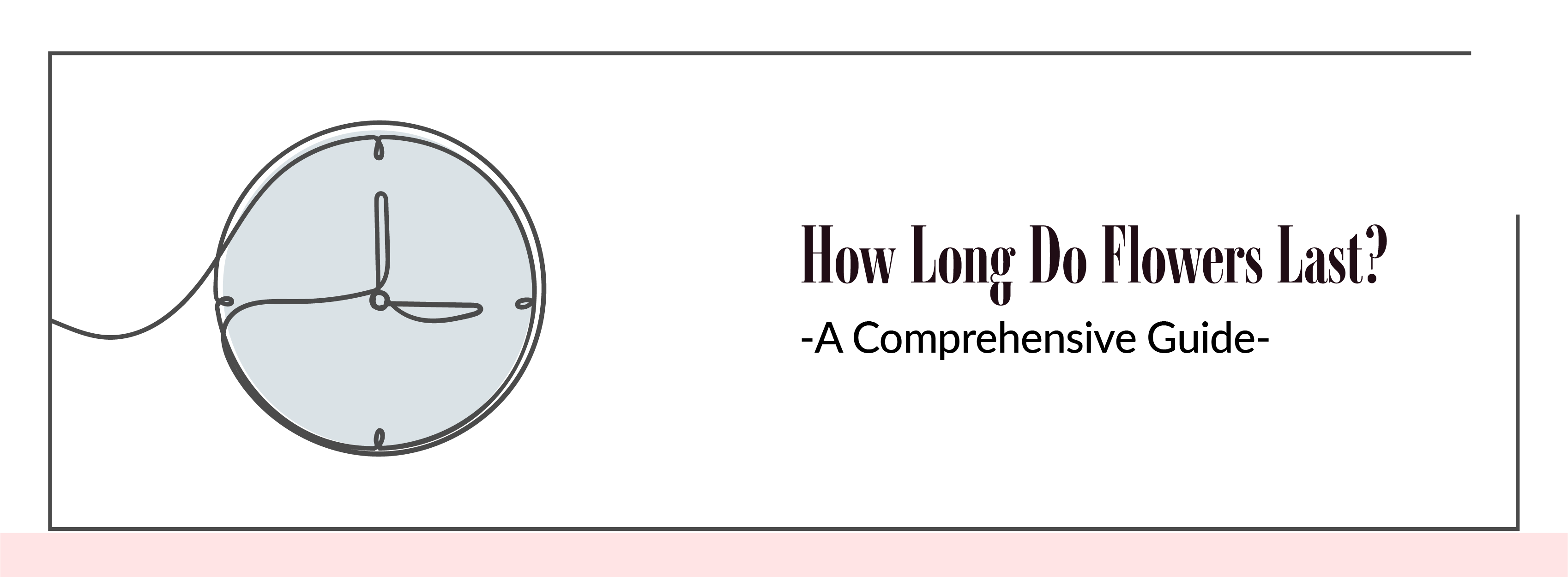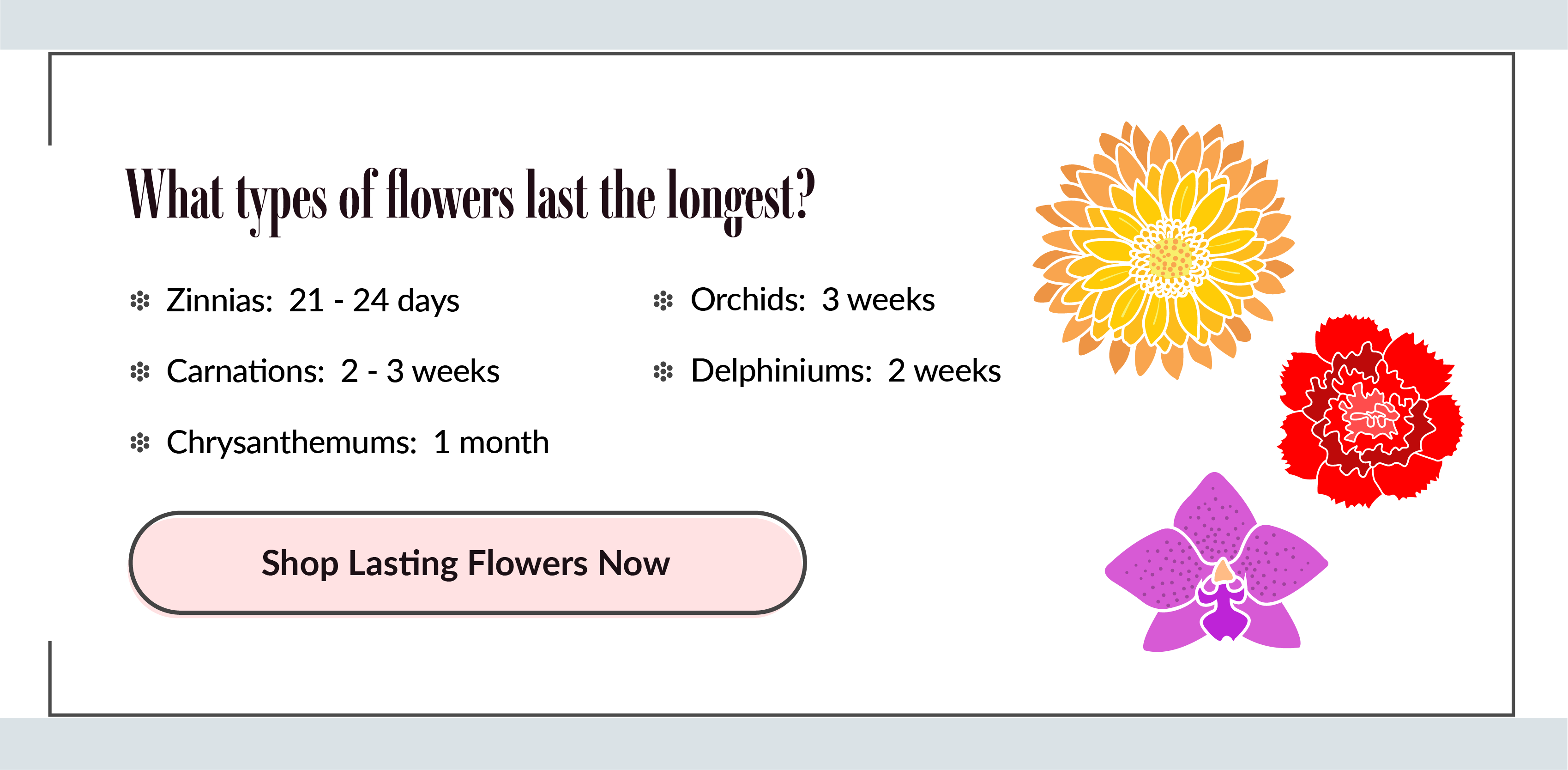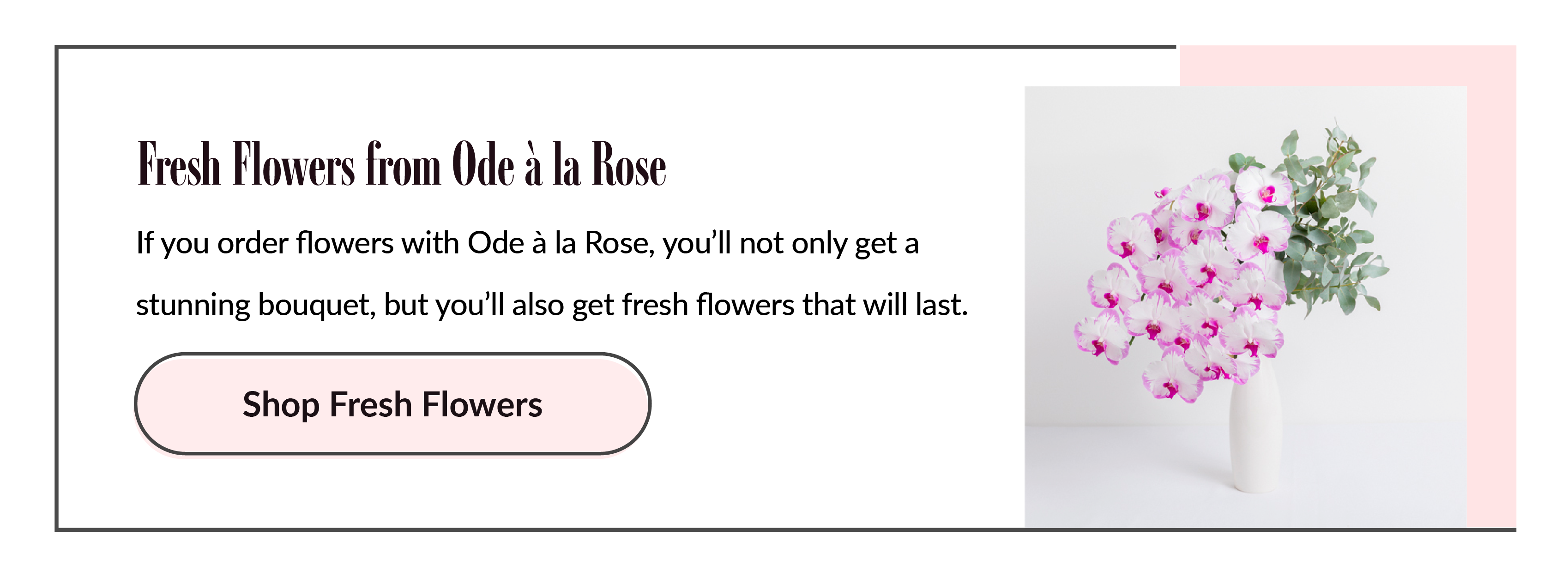Whether you’ve received a stunning floral arrangement or you plan to give one as a gift, you may wonder how long it’ll last and how to keep these flowers fresh. You want to remember the occasion you received the flowers for or keep your space colorful for as long as you can.
If you know how to care for flowers, your blooms will have a better chance at a longer life. You or your recipient will be able to keep the flowers on display, which brightens up a space or serves as a reminder of the kind gesture. Read on for a comprehensive guide to keeping flowers fresh and a look into how long they last in an array of situations.
- How Long Do Flowers Last in a Vase?
- How Long Do Flowers Last in Floral Foam?
- How Long Do Flowers Last in the Fridge?
- How Long Do Flowers Last in the Car?
- How Long Do Flowers Last Once They’re Cut?
- How Long Do Flowers Last Out of Water?
- Does Aspirin Make Cut Flowers Last Longer?
- What Types of Flowers Last the Longest?
- How Can You Prolong the Life of Your Flowers?
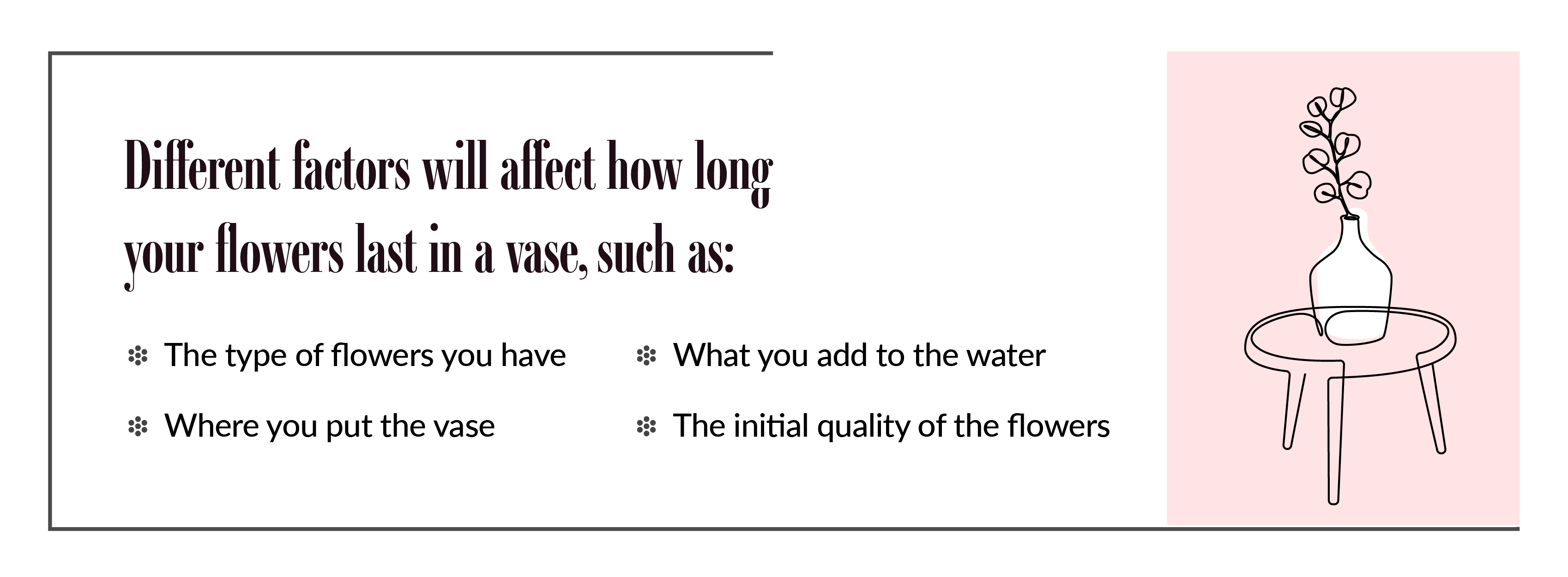
How Long Do Flowers Last in a Vase?
Different factors will affect how long your flowers last in a vase, such as:
- The type of flowers you have
- Where you put the vase
- What you add to the water
- The initial quality of the flowers
The variety of blooms you choose in an arrangement has the most significant impact on vase life. Roses can last seven days or more, while carnations can last two to three weeks. The vase life of any bloom, of course, also depends on correct maintenance.
Display your flowers in the right area to maintain a longer vase life. Avoid keeping a vase in direct sunlight since that will dry out flowers quicker. You also want the container in a cool area, but not exposed directly to a fan or air conditioner since that could dry out the flowers. Another enemy of flowers in a vase is bacteria. To prevent bacteria growth that can harm your flowers, be sure to:
- Use a clean vase: It may seem obvious, but be sure your vase is well-cleaned before filling with lukewarm water and adding your flowers. Clean the vase whenever you change the water, wiping out any residue that could allow bacteria to grow.
- Change the water regularly: Once every day or two, swap out your vase’s water. Avoid topping up water as this will not eliminate any bacteria that are present. Instead, dump out the old water and wash the vase before replacing with fresh lukewarm water.
- Don’t let anything sink below the surface: Greenery and petals become a home for bacteria when resting on or below the water’s surface. Choose a vase that accommodates the height of your blooms and trim any leaves lower on a stem to avoid bacteria growth.
- Be careful with additives: Some homemade flower foods contain sugar, which does provide the blossoms with the food they need. However, without a disinfectant added, the sugar may help more bacteria grow. Balance it out with bleach to disinfect and lemon juice for an acidifier.
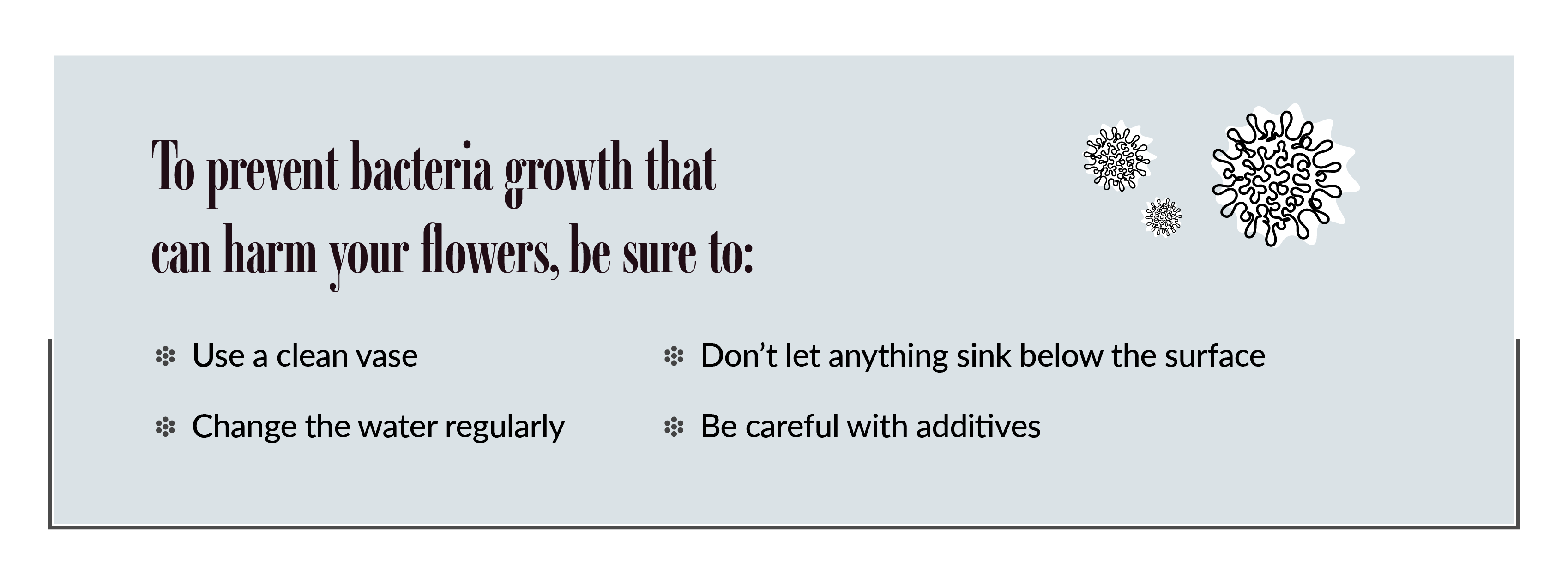
Some additional tips to make your flowers last longer in a vase:
- Cut Stems – Don’t be shy, trim the stems with a knife before arranging your flowers in a vase. It will allow the flowers to take up water. And remember, the more you cut on a slant, the more surface is exposed to water.
- Remove Leaves – Remove all the leaves that are underwater in your vase. It will help your flowers to last longer and prevent bad odors from the standing water.
- Add Salt – No, it’s not a cooking class today, but adding a pinch of salt to the water is another tip to keep your flowers fresh. Baking soda works too.
- Keep it Cool – During summer or whenever it’s hot outside, place your bouquets in the coolest rooms and you can even add a few ice cubes in the water. During the winter, avoid exposing your flowers to freezing temperatures.
- Add Hairspray – Ladies, it’s time to run to your bathroom to grab your hairspray. However be sure to leave your brush on your dressing table, flowers don’t require any blow-dry. Give your roses a very light spritz of hairspray and they will look better for a few days more.
With proper care, you have a better chance of your flowers lasting longer in a vase. Keep everything clean, and you may see a vase life of more than a week.
How Long Do Flowers Last in Floral Foam?
A flower’s longevity in floral foam is dependent on similar factors to vase life. Keep the display in an area that isn’t too hot or too cold and away from sunlight. Also, ensure the container is clean. To set up and maintain your floral foam for the best results, you will want to:
- Soak the foam adequately: As water enters floral foam, air needs to exit. Allow this exchange by placing the foam on the surface of the water in a tub or basin. Fill the container to a depth of water that is about the same height as the block of foam. Resist the urge to submerge the block because it will absorb water better when floating. Let it soak for a few minutes, or until you can feel enough moisture come out when you gently poke the surface.
- Choose the right flower food: Certain mixes of flower food cannot flow through a block of foam. As a result, particles can get trapped in the block and cause bacteria growth. Use a liquid food that doesn’t have particles and can kill bacteria.
- Cut the foam correctly: Only try to cut floral foam after it has soaked. If you try to cut dry foam, you risk crushing the delicate cells that are meant to hold water for your blooms. When you do cut it to size for a tall vase or container, cut it a bit smaller than you need. Your goal is to avoid crushing the foam as you put it inside the vase, so a smaller cut will make this easier. If you’re putting the block in a shallow container, use floral tape to put a cross shape over the foam and secure it to the sides of the container.
- Add flowers carefully: You want a snug fit with your stems in the foam. To achieve the right fit, do not pre-puncture holes since they may be too wide for the stems. Instead, cut the stems at a sharp angle and insert them into the foam. You can use a wooden florist pick to help flowers stand straight, which is helpful for weak stems or horizontal arrangements.
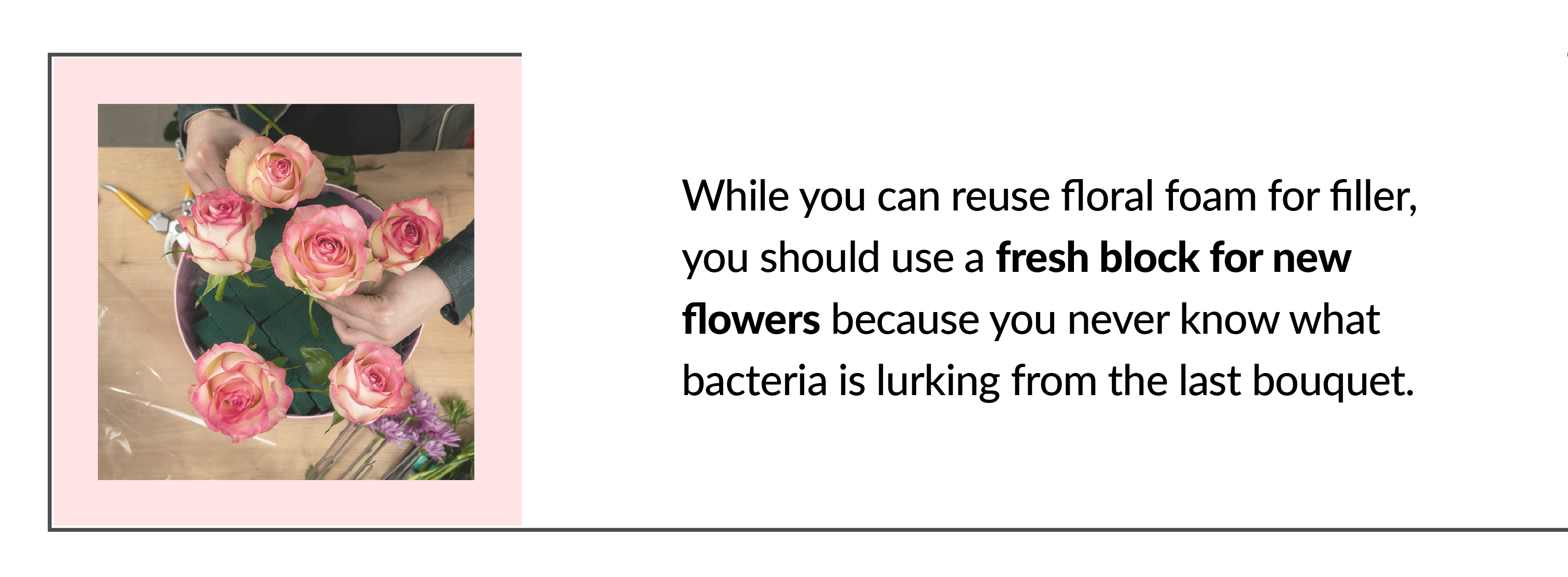
While you can reuse floral foam for filler, you should use a fresh block for new flowers because you never know what bacteria is lurking from the last bouquet. Check the moisture level and top up when the foam feels dry to help it last.
With proper maintenance, your blooms may last longer in flower foam than in a vase. Depending on the blooms you use, your bouquet may last for a week or more.
How Long Do Flowers Last in the Fridge?
You can extend the vase life of flowers if you put them in the refrigerator. Keeping them cool doesn’t mean you’ll only see your blooms when you get something from the fridge, though, because they only need to be in there overnight.
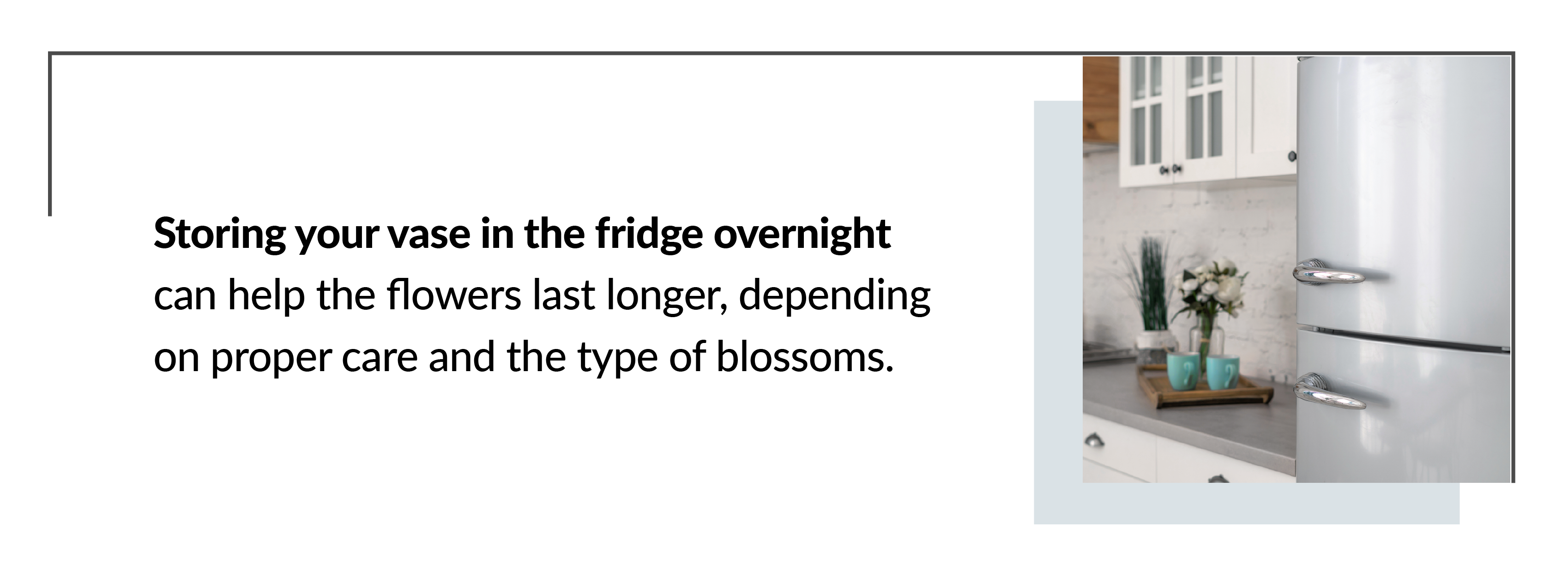
Storing your vase in the fridge overnight can help the flowers last longer, depending on proper care and the type of blossoms. You do need the right setup in your refrigerator before introducing your flowers to the cold, so remember to:
- Keep the temperature right: Set your fridge to about 40 degrees Fahrenheit. Flowers can withstand the cold, but you don’t want to freeze them or the water in their vase. If an area of your fridge gets colder than the rest, especially the back, avoid keeping flowers there.
- Make some room: You don’t want your flowers crowded among everything you keep in your fridge. Clear an area for the vase and make sure there is enough room between the flowers and the top of the fridge. Move shelves down if you can or if you need the space. Without enough room, you risk damaging your blossoms.
- Move the produce: Keep your flowers away from certain fruits and vegetables because they produce a gas that speeds aging. Your safest bet is to remove produce from the fridge since it would be counterproductive to keeping flowers preserved in the cold.
If storing flowers in the fridge overnight isn’t a convenient option for you — whether you have a lack of space or an excess of fruit — you can keep them in a cold area instead. Lower the heat or turn up the air conditioner, but do not put the flowers near a fan because that may dry them. As long as you keep blooms cool, it will slow the aging process, and your bouquet may last a few days longer than expected.
How Long Do Flowers Last in a Car?
If you’re bringing flowers to someone or somewhere else, you’ll want to know how long flowers will last in a car. The longevity of your blooms, when left or transported in a car, depends mainly on the weather outside. If it is too cold out, your flowers may freeze. If it is too hot, they could wilt. Even a couple of hours in a hot car can leave your flowers looking lackluster.
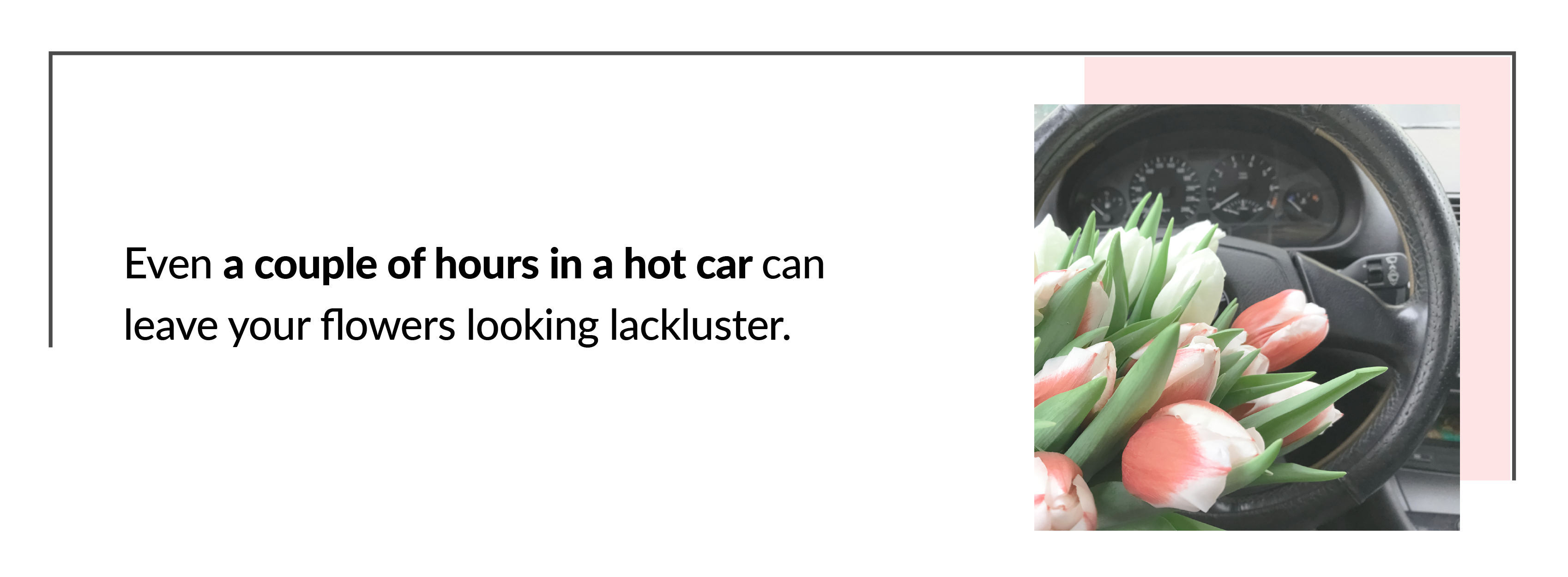
Luckily, if you’re in the car when the flowers are, you can control the temperature. Quick stops should be fine, but leaving flowers alone for long periods in your vehicle could spell trouble. You’ll also want to take care when transporting the flowers. One quick turn or wrong bump could mean a spill, and your flowers won’t last long without water.
To secure your bouquet that’s in a vase, use a box to keep it stable. Wrap the vase with a towel to keep it balanced, and put the box on a flat surface like the floor. Give the flowers enough water to keep the stems wet, but there’s no need to fill the vase over a third of the way.
To transport multiple bunches, consider a larger bucket. You can stabilize it in a box, as well, but you will need something more substantial on the sides than a towel. Again, don’t fill the vessel too much. Try not to crowd the blossoms, either, as you risk damaging petals and buds.
If you have to leave your flowers in the car for over two hours, try to keep them out of the sun. Set them on the floor and give them shade, but don’t be surprised if they look a little less perky when you come back to them.
How Long Do Flowers Last Once They’re Cut?
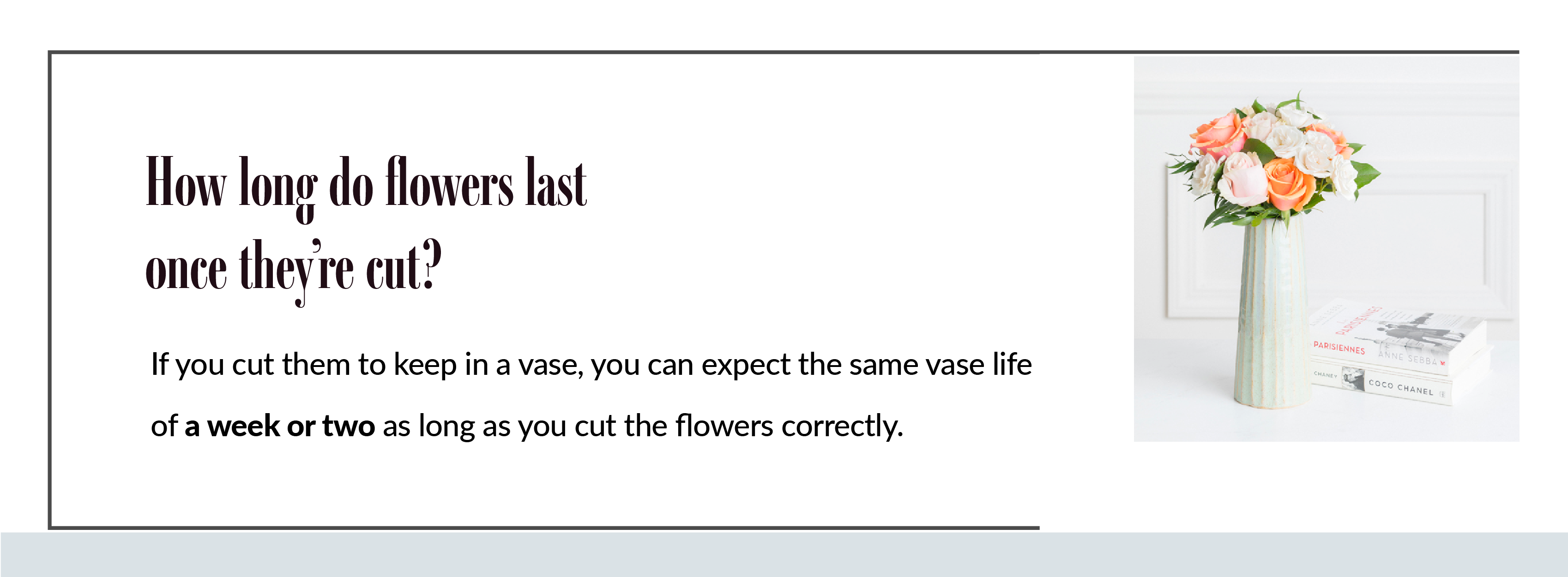
How long flowers last after they’re cut depends on where you place them after. If you cut them to keep in a vase, you can expect the same vase life of a week or two as long as you cut the flowers correctly. To do so, be sure to:
- Use something sharp: A dull blade risks crushing a stem, and a crushed stem won’t be able to drink up as much water as an open one. Use a sharp knife or pruning shears to get the best cut.
- Cut at an angle: Be sure that every stem is at an angle when you cut them. A flat stem will sit flush with the bottom of a vase, meaning the stem won’t get the water it needs.
- Expose the stems to water: Avoid air when cutting stems. Hold them under running water when cutting or do it with the stems underwater. Air exposure may seal the end of a stem, meaning the flower can’t drink up any water.
- Choose the right time of day: In the early morning or late evening, a plant contains the most water it will have all day. When cutting flowers, do so at either of these times of day to ensure your flower has enough water and nutrients inside. It will be more stable while you cut and transport it with a reserve of nutrients.
- Use flowers at their ideal maturity: Depending on the type of flower you want, you or a florist should cut it at the right stage of its life. Cut blooms like daffodils, irises, tulips, and peonies, at the budding stage before they open. When flowers like marigolds, daisies, orchids, and violets fully open, they are good to cut.
- Re-trim when necessary: After two or three days, you’ll have to re-trim your stems. Try to make the new cut about an inch above the previous one to allow your stem the best chance at being open.
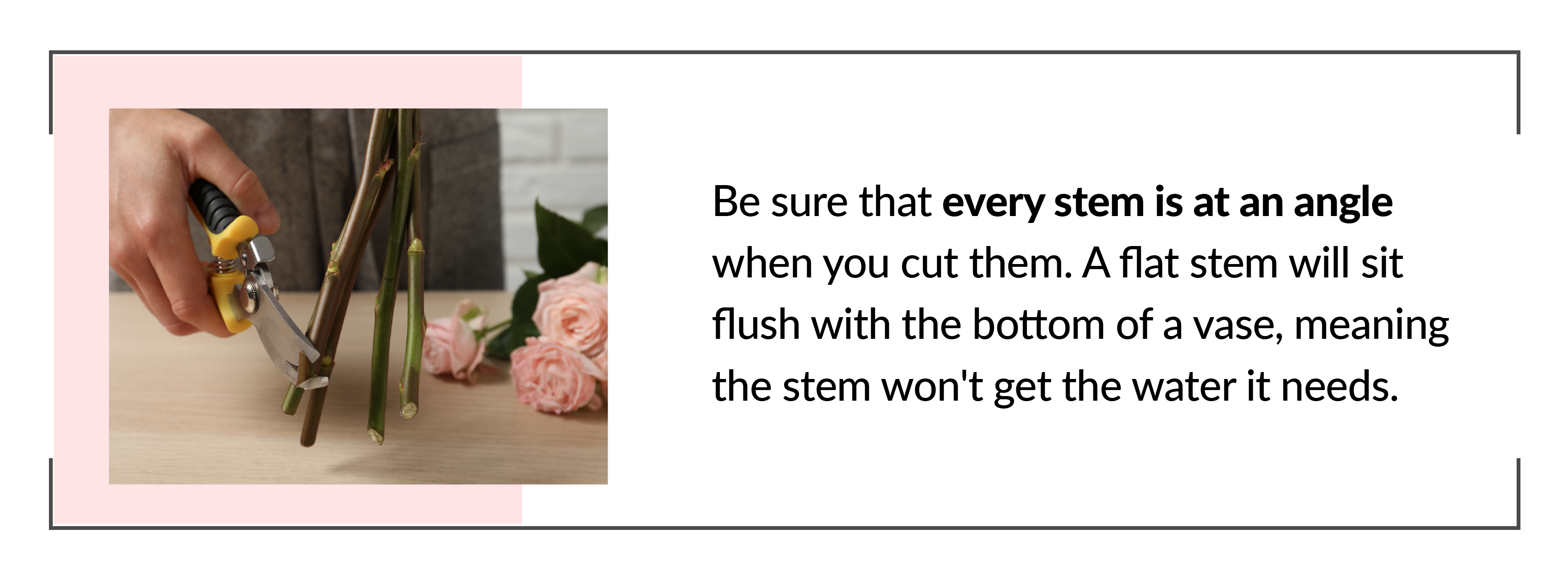
You have to cut flowers to put them on display, but the key is to work smart and fast. When in doubt, do what you can to ensure the flower can drink through its stem. If you’re purchasing from a florist or flower company, choose a trusted one that works with fresh flowers. Their knowledge and experience will help guarantee that you get fresh, quality flowers cut right. From there, it’s up to you to maintain their freshness and trim them when needed.
How Long Do Flowers Last out of Water?
Whether you’re trimming flowers from a florist or cutting your own, you don’t want to leave them without water for long. As soon as you cut a flower without exposing it to water, it begins to decline. Depending on the type of bloom you’ve trimmed, it may take several hours before you see visible effects, such as wilting or drying. To prevent damage to your cut flowers, you should:
- Choose a healthy plant: If you’re cutting your own flowers, be sure to choose a strong and healthy plant. Some flowers are more delicate than others, so be sure to treat all blossoms with care, but give extra attention to the fragile ones. They won’t last as long without water. A knowledgeable flower company or florist will take the same precautions.
- Cut in a cool environment: Try not to trim flowers on hot days or in hot rooms. Heat and bright sunlight are other environmental factors that will shorten a dry flower’s lifespan even more. Your working time can drop from a few hours to one if other factors aren’t favorable for your flowers.
- Prepare before you cut: Have a clean vase or another vessel with lukewarm water ready to go before cutting the flowers. You can make the transition much quicker if you make preparations, and your blooms won’t have to wait long before getting the water they need.
- Wrap the stems: If something prevents you from getting flowers in a vase or floral foam right away, wrap the cut ends with a wet paper towel. Add plastic wrap around the paper towel if you need a bit more time as it will keep the towel from drying out as quickly.
- Transport flowers with water: When taking a bouquet from one location to another, be sure the flowers have water. For a quick trip, wet paper towels and plastic wrap around the stems should be enough. For anything longer, though, keep the blooms in a vase or other container. You don’t want to show up with dry or wilted flowers.
If your flowers were out of water for an hour or longer, put food or preservatives in their water. Trim the stems again, about an inch from the last cut, and be sure to hold them under running water. Add them to the vase and store them properly in the fridge overnight. As long as they were not too wilted or dry after being left without water, you may be able to revive your blooms.
Does Aspirin Make Cut Flowers Last Longer?
No, Aspirin does not make cut flowers last longer. Even though it’s commonly said that adding aspirin to the water of your roses will keep them healthy, there’s no scientific evidence at all. FloraHolland, a flower auction company, launched a study on the subject and carried out laboratory tests (parameters being as close as possible to those of an apartment). The findings were as follows: aspirin has no positive effect on the longevity of fresh cut flowers.
What Types of Flowers Last the Longest?
While maintaining your bouquet will improve its longevity, choosing durable blooms in the first place will help even more. Some long-lasting flowers include:
Zinnias – 21 to 24 days
Are you tired of buying flowers that don’t even make it to the end of the first week before they start sagging or losing petals? Zinnias will often last for three weeks—and potentially even longer. In fact, many florists will tell you that zinnias can last for 24 days after they are cut.
Carnations – 2 to 3 weeks
Carnations are popular for their affordable prices, beautiful blooms, and vibrant colors. They also give you a big bang for your buck regarding lifespan, lasting two to three weeks after cutting.
Chrysanthemums – 1 month
Zinnias are often considered the undisputed champions of the long-lasting flower competition. However, chrysanthemums have the potential to live even longer. It’s not unheard of for a vase of chrysanthemums to last for a month after they are cut. The catch is that chrysanthemums are higher maintenance than zinnias. You will need to swap out the water and trim the stems every day if you want to get to the three or four-week mark.
Orchids – 3 weeks
Orchids can also rival zinnias in longevity, often reaching three weeks before withering. They aren’t quite as high-maintenance as chrysanthemums, but still demand new water and stem trimming every other day. Be careful while you are changing the water, though: orchids have very delicate petals.
Delphiniums – 2 weeks
Delphiniums can’t muster up a three-week lifespan, but they will often make it to two weeks without too much difficulty. As your florist will likely tell you when you purchase a bouquet of delphiniums, though, ethylene gas is like kryptonite to these flowers. Since fresh produce will often create trace amounts of ethylene gas, it’s best to display the delphiniums somewhere outside of the kitchen—at least if you want them to last.
When you care for these long-lasting flowers, they are sure to reach their full potential. The key is picking the right blooms before cutting.
Keep in mind if you get a bouquet of flowers at the supermarket, there’s a chance that it has been sitting out for three or four days already—often without new water or proper trimming. If you want flowers that are going to last a long time, you should buy freshly cut flowers from a professional florist.
A knowledgeable florist gathers fresh flowers from trusted sources, but if you’re cutting from your own selection, be sure to learn when to cut different types of blossoms. In general, you should avoid picking flowers that are too open or already have dry or brown petals. Once you have the right flowers, it’s up to you to keep them fresh for as long as you can.
How Can You Prolong the Life of Your Flowers?
Cut flowers will eventually wilt, but you can give your lovely arrangements a longer life with special care. While we’ve provided some tips above on how to prolong the life of your flowers, they are worth repeating. To keep flowers fresh, be sure to:
- Keep flowers cool and out of the sun, but don’t freeze them.
- Give your flowers plenty of water and food.
- Use sharp, disinfected shears or a knife to cut stems.
- Cut stems at an angle, underwater, and an inch above the last cut.
- Eliminate bacteria from your flowers’ water.
- Display flowers away from fruits that produce ethylene gas.
Flowers are too beautiful and beneficial not to put them on display. Whether you grow your own blooms or get fresh ones from a flower company, your room will feel brighter and happier. The delicate fragrance of fresh flowers will improve your mood, especially when you see how well the blooms are doing with the right care.
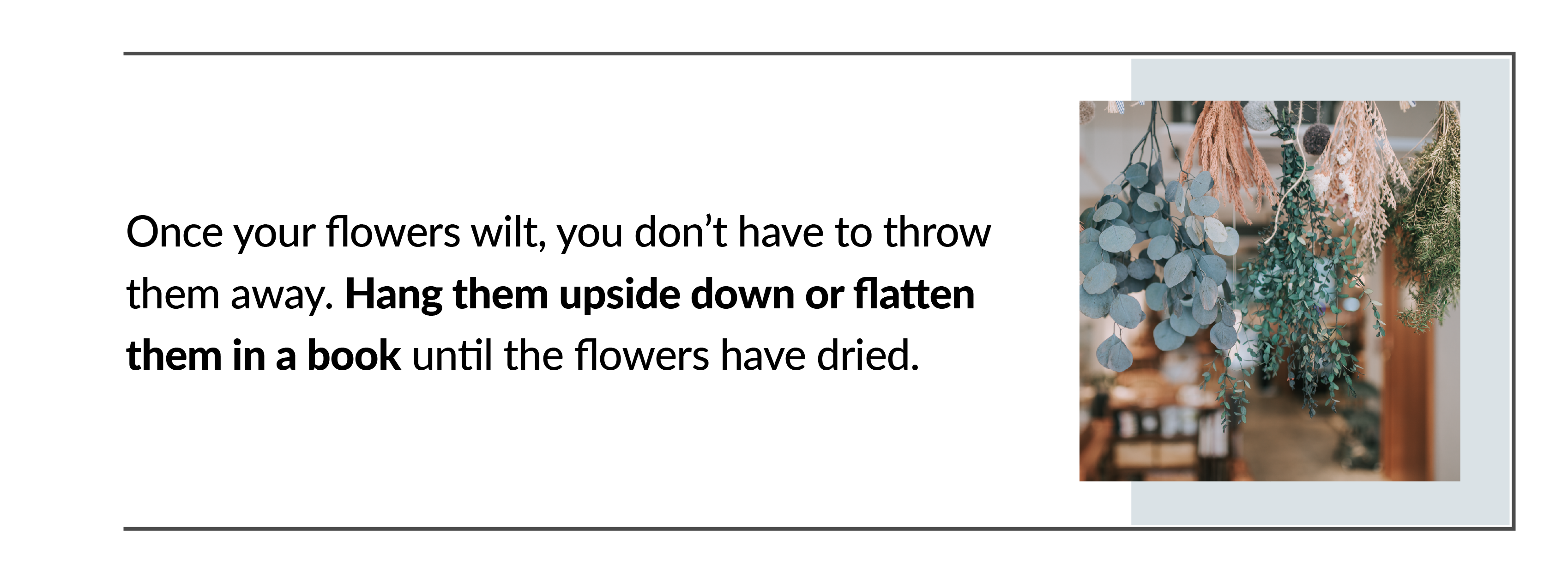
Once your flowers wilt, you don’t have to throw them away, especially if they were for a special occasion. Hang them upside down or flatten them in a book until the flowers have dried. Use the preserved flowers as decorations or keep them safe pressed in the book you used.
What Does Ode à la Rose Do to Keep Flowers Fresh?
If you order flowers with Ode à la Rose, you’ll not only get a stunning bouquet, but you’ll also get fresh flowers that will last. We ensure the freshest flowers and most elegant arrangements by:
- Working with worldwide, trusted suppliers
- Preparing bouquets with trained florists
- Offering same-day delivery in New York City, Chicago, Philadelphia, Los Angeles, Miami, Austin, and Washington DC
- Offering next-day delivery throughout the Northeast
- Sending our arrangements with the stems in a water-filled container
- Delivering bouquets in our signature gift box, designed to protect the flowers
- Protecting delicate blossoms and petals with tissue paper
On top of that care and attention to detail, we also send you a photo of your bouquet so you know exactly what it will look like when it arrives. Browse our selection of eye-catching bouquets when you need to send flowers to a friend, family member, or significant other. We have flowers for any occasion from anniversaries to birthdays and more. Contact us if you have any questions about our arrangements or delivery process. We’ll be glad to help you create the perfect gift for someone or treat yourself to a lovely bouquet.

